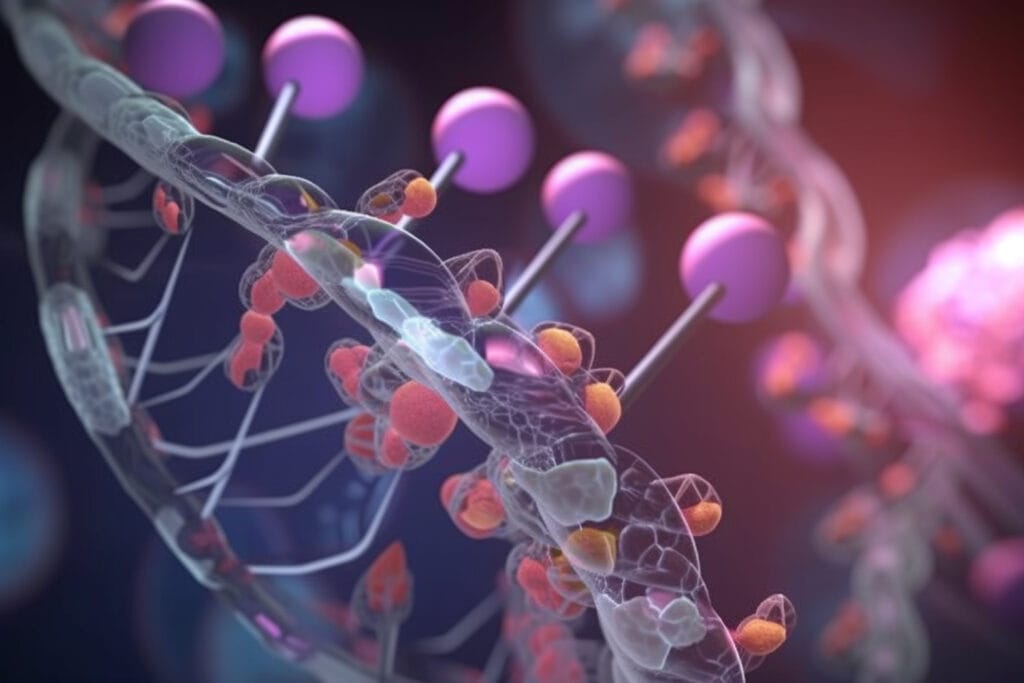Introduction: Understanding CRISPR and Its Role in Genetic Engineering
In recent years, CRISPR has taken the scientific world by storm, revolutionizing the field of genetic engineering. This technology enables precise DNA edits, creating opportunities in medicine, agriculture, and more. But what exactly is CRISPR, and why is it so groundbreaking?
CRISPR, which stands for “Clustered Regularly Interspaced Short Palindromic Repeats,” is a bacterial defense mechanism against viruses. Scientists have used this system to efficiently edit genes in other organisms, making it a powerful tool for DNA modification. CRISPR may revolutionize disease treatment, crop enhancement, and human evolution in the future.
What is CRISPR? A Brief Overview of Gene Editing Technology
CRISPR, a gene-editing technology, functions as molecular scissors to cut and modify DNA at specific sites. Cas9 guides RNA to DNA, acting as the “scissors” protein.
This breakthrough has made CRISPR one of the most versatile and powerful tools in modern biology. Ucrispr performs quick and precise targeted genome modifications, unlike older methods that were slower and less exact. Genetic engineering’s user-friendly approach spurs interest and research in fields such as medicine, agriculture, and environmental science.
How The Revolutionizing Is In Genetic Research?
The advent of CRISPR has transformed genetic research in unprecedented ways. Prior to its development, genetic modifications were slow, expensive, and prone to errors. But now, thanks to this technlogy, scientists can alter genes with pinpoint accuracy and at a fraction of the cost.
One of the most exciting aspects of this technology is its potential to study the function of specific genes. By modifying genes, researchers can understand the impact on organisms, yielding insights into genetic diseases, developmental biology, and evolutionary biology.Researchers can study gene impact, enhancing genetic diseases, developmental biology, and evolutionary biology knowledge. This ability to manipulate genes on demand has paved the way for groundbreaking discoveries in genetics and molecular biology.
From Genetic Disorders to Cancer
The potential for CRISPR in medicine is nothing short of revolutionary. One of the most promising applications is in the treatment of genetic disorders. this technology could potentially cure single-gene diseases like cystic fibrosis, Huntington’s, and sickle cell anemia by correcting faulty genes.
In addition to genetic disorders, this technology holds immense potential in the fight against cancer. CRISPR could enhance immune cells for improved cancer cell targeting, advancing personalized treatments. Immunotherapy shows promise in early trials, bringing hope to cancer patients worldwide.
CRISPR in Agriculture: Engineering Crops for a Sustainable Future
The impact of this technology extends beyond medicine; it’s also transforming agriculture. With the global population steadily rising, the need for sustainable and efficient farming practices has never been greater. Immunotherapy in early trials shows promise for cancer patients globally.
Scientists used CRISPR to create drought-resistant crops, reducing farming’s environmental impact. Technology enhances crop nutrition, like vitamin-enriched rice, aiding in combatting malnutrition in developing nations. Evolving CRISPR may sustainably feed the world’s growing population.
Balancing Innovation and Morality
While the possibilities of this technology are exciting, they also raise significant ethical concerns. The debated topic involves creating “designer babies” using CRISPR to choose traits like intelligence, appearance, or athleticism in children. This has led to fears of creating a new form of genetic inequality.
Moreover, the long-term effects of editing the human genome are still unknown, and unintended consequences could arise. The use of this technology in embryos, which would pass genetic changes to future generations, is especially controversial. While the technology offers hope for curing genetic diseases, it also raises the question: just because we can, should we? Establishing clear guidelines and ethical frameworks for this technology use is crucial as we progress.

Emerging Technologies in Genetic Engineering
Although this technology has dominated the headlines, it’s not the only game in town. Other gene-editing technologies, such as base editing and prime editing, are emerging as powerful alternatives or complements to this technology. These newer methods offer even greater precision, potentially allowing for the correction of single DNA letters without the need for double-stranded DNA breaks, as in the case of CRISPR-Cas9.
Additionally, advancements in synthetic biology and gene drives are pushing the boundaries of genetic engineering further. These innovations are poised to address some of the limitations of this technology and open up new possibilities for everything from curing diseases to controlling invasive species. As research in genetic engineering continues to progress, we may soon see technologies that go “beyond CRISPR” in terms of efficiency and capability.
CRISPR vs. Traditional Genetic Modification Techniques: A Comparison
Traditional genetic modification techniques, such as selective breeding and recombinant DNA technology, have been used for decades to alter the traits of plants and animals. However, these methods are often slow, imprecise, and costly. In contrast, this technology offers a much faster, cheaper, and more accurate way to edit genes.
While traditional methods typically involve adding foreign genes into an organism’s genome, this technology allows for the precise editing of existing genes, which reduces concerns about unintended effects or cross-species gene transfer. The scientists can target specific genes without affecting others, minimizing the risk of off-target effects. As a result, this technology is quickly becoming the preferred method for genetic modification in both research and industry.
Challenges and Risks Associated with CRISPR Technology
Despite its many advantages, CRISPR is not without its challenges. Off-target effects are one of the biggest concerns, as they can lead to harmful mutations by inadvertently editing unintended parts of the genome. While researchers are working to improve the accuracy of this technology, these unintended edits remain a significant risk.
Moreover, the use of this technology in humans raises questions about consent and long-term safety. Editing the genes of embryos, for example, could have unforeseen consequences that affect future generations. There’s also the challenge of ensuring equitable access to CRISPR technologies, as not all populations or countries may have the same level of access to these groundbreaking treatments.
The Future of CRISPR: Potential Advancements and Innovations
As CRISPR technology continues to evolve, the future looks incredibly promising. One potential advancement is the development of more precise gene-editing tools, such as CRISPR-Cas12 and CRISPR-Cas13, which target RNA instead of DNA.These new tools could expand the range of diseases that crispr can treat, including viral infections and certain types of cancer.
Another exciting area of research is the use of this technology or gene therapy. By delivering this directly to affected tissues or cells, scientists hope to cure genetic diseases in a single treatment. As technology matures, we may also see personalized medicine rise, where we use CRISPR to tailor treatments to an individual’s genetic makeup.
How CRISPR Could Shape the Future of Personalized Medicine
In the field of personalized medicine, where treatments are tailored to an individual’s genetic profile, this technology holds immense potential. With this, doctors could one day edit a patient’s DNA to treat diseases that are currently incurable, such as genetic disorders, certain types of cancer, or even heart disease.
By targeting the specific genetic mutations that cause these conditions, Cas9 could offer more effective and less invasive treatments. Furthermore, researchers could use this technology to modify a patient’s immune cells to enhance their ability to fight off diseases or infections, thus increasing the potential for personalized medicine in the future.
CRISPR and the Possibility of Designer Babies: Hype or Reality?
One of the most controversial aspects of CRISPR is the possibility of creating “designer babies,” where parents could choose their child’s traits, such as intelligence, appearance, or athleticism. While science fiction often portrays this idea, it is not entirely out of the realm of possibility.
However, the reality is more complex. CRISPR may modify some traits, but complex factors like genes and environment affect control of traits like intelligence and personality.
Scientists and policymakers agree on the need for strict regulations to prevent the misuse of this for non-medical purposes due to its enormous ethical and social implications.
Global Regulations and Policies Surrounding CRISPR Technology
As CRISPR technology advances, governments around the world are grappling with how to regulate its use. Different countries have adopted varying approaches to it’s regulation, with some allowing gene editing in certain contexts, while others have imposed strict bans.
For instance, China has been more open to gene-editing experiments, even allowing the editing of human embryos in some cases, while countries like the United States and Europe have stricter guidelines. As CRISPR becomes more widely used, international cooperation will be essential to establish clear, consistent regulations that ensure the technology is used safely and ethically.
CRISPR and Gene Drives: Controlling Ecosystems and Species
Another intriguing application of CRISPR is the development of gene drives, which are designed to spread specific genetic traits through a population of organisms, such as mosquitoes or other pests. This could potentially be used to combat diseases like malaria by engineering mosquitoes that are unable to carry the parasite.
However, the use of gene drives raises significant ecological concerns. Releasing genetically modified organisms into the wild could have unintended consequences, such as disrupting ecosystems or causing the extinction of certain species. While gene drives offer promising solutions to global health and environmental challenges, they must be used with extreme caution to avoid unintended harm.

The Role of AI and Machine Learning in Advancing CRISPR Research
Artificial intelligence (AI) and machine learning are playing an increasingly important role in CRISPR research. By analyzing vast amounts of genetic data, AI can help researchers identify new targets for gene editing, predict the outcomes of genetic modifications, and improve the accuracy of CRISPR tools.
For example, AI can be used to predict off-target effects, helping scientists develop more precise gene-editing techniques. As AI and machine learning technologies continue to advance, they will likely accelerate the development of CRISPR-based therapies and expand the range of applications for gene editing in both medicine and agriculture.
In conclusion, the future of genetic engineering is bright, and this technology is at the forefront of this revolution. With its ability to make precise edits to DNA, this technology is opening up new possibilities in medicine, agriculture, and beyond. However, as we move forward, it is essential to carefully consider the ethical, social, and ecological implications of this powerful technology. With the right balance of innovation and responsibility, CRISPR could help us solve some of the world’s most pressing challenges, from curing genetic diseases to feeding a growing population.

